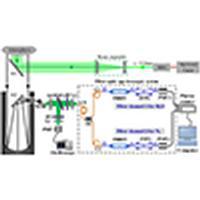当前位置:
X-MOL 学术
›
J. Opt. Soc. Amer. B
›
论文详情
Our official English website, www.x-mol.net, welcomes your feedback! (Note: you will need to create a separate account there.)
Compact fiber-optic spectroscopic design and its validation in atmospheric water vapor Raman lidar
Journal of the Optical Society of America B ( IF 1.9 ) Pub Date : 2020-03-05 , DOI: 10.1364/josab.384944 Yufeng Wang , Lisong Jia , Xingxing Li , Fulei Fan , Huige Di , Yuehui Song , Dengxin Hua
Journal of the Optical Society of America B ( IF 1.9 ) Pub Date : 2020-03-05 , DOI: 10.1364/josab.384944 Yufeng Wang , Lisong Jia , Xingxing Li , Fulei Fan , Huige Di , Yuehui Song , Dengxin Hua

|
Spectroscopic systems with compact structure, high reliability, and high stability will push forward the application of lidar in the meteorological and environmental fields as well as space-based and space-borne lidar. Recently, we have successfully designed and verified a new robust fiber-optic spectroscopic Raman lidar for atmospheric water vapor measurements. The compact fiber-optic Raman spectroscopic design was proposed with a cascaded fiber Fabry–Perot filter and a fiber broadband filter, which features an all-fiber-connection structure and a high-spectral-resolution spectrum. These fiber-optic filters have been successfully fabricated in the visible region and matched each other in individual all-fiber Raman channels. The performance of the all-fiber spectroscopic system is measured experimentally, and it is demonstrated that the spectral output from the individual fiber Raman channel provides a bandwidth of 3–4 nm, a central wavelength of 660 nm or 606.7 nm, and an efficient rejection rate of more than $ {\gt} {{10}^7}$, and it can thus achieve the extraction of vibrational Raman scattering signals from water vapor and from nitrogen molecules in lidar returns and simultaneously reject elastic scattering signals. Furthermore, the fiber-optic spectroscopic Raman lidar was developed at Xi’an University of Technology in Xi’an, China (34.233°N, 108.911°E), and preliminary exploration was carried out for water vapor measurements. Two measurement examples are analyzed to validate the lidar performance and the retrieved water vapor mixing ratio profiles, and its comparisons with Weather Research and Forecasting (WRF) model data also verified the correctness of the lidar data. Despite the limitation of low coupling efficiency by a single-mode optical fiber, atmospheric water vapor measurements up to 700 m were achieved during nighttime under conditions of a 150 mJ laser pulse energy, a 600 mm telescope, and a 5 min integration time. The results validated the concept of all-fiber spectroscopic design and its feasibility for atmospheric water vapor measurements by Raman lidar. The compact fiber-structure characteristics and excellent optical properties provide a new solution to the new spectroscopic technique for operational applications of lidar and space-borne lidar.
更新日期:2020-03-05

























 京公网安备 11010802027423号
京公网安备 11010802027423号